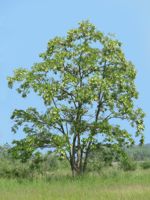Mon-Fri 9am - 5pm Mountain time
Black Locust vs Blue Moon Wisteria
Robinia pseudoacacia
Wisteria macrostachya Blue Moon
Black Locust is an attractive tree. Its distinctive leaves are made of about a dozen bright green leaflets. It also notable for its fragrant white flowers, which smell of citrus.
Black Locust can grow in many situations, but prefers dry areas with lots of sun. It is robust and is an excellent choice for establishing shade in dry, open areas.
Important note: Much of the Black Locust is toxic to humans and livestock, including seeds, bark, and leaves.
Blue Moon Wisteria is a striking, flowering vine, and the hardiest of the wisterias. Up to three times in one growing season you can expect showy, fragrant, lavender-blue flowers.
Make sure you plan your site as this vine requires a structure to support its mature weight. Try planting close to a post, trellis, or fence.
Black Locust Quick Facts
Blue Moon Wisteria Quick Facts
Toxicity: can be toxic to cats, dogs, and horses when consumed

